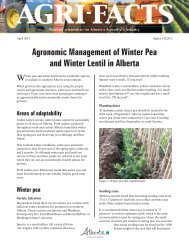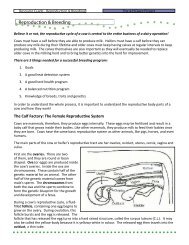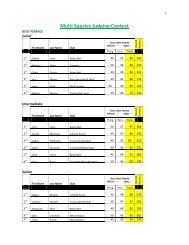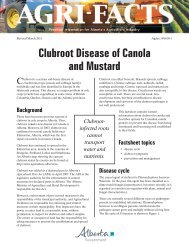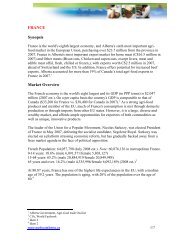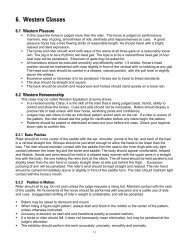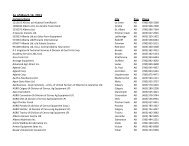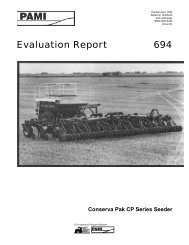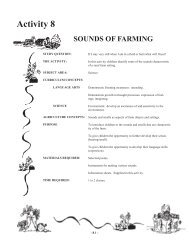Automatic Livestock Waterers - Agriculture and Rural Development
Automatic Livestock Waterers - Agriculture and Rural Development
Automatic Livestock Waterers - Agriculture and Rural Development
Create successful ePaper yourself
Turn your PDF publications into a flip-book with our unique Google optimized e-Paper software.
Revised December 2008 Agdex 716 (C52)<br />
<strong>Automatic</strong> <strong>Livestock</strong> <strong>Waterers</strong><br />
A<br />
reliable, constant supply of good quality water is<br />
an essential part of any livestock enterprise.<br />
<strong>Automatic</strong> waterers are st<strong>and</strong>ard equipment on most<br />
farms because of their convenience <strong>and</strong> efficiency (Figure<br />
1). They consist of an insulated base <strong>and</strong> a heated bowl<br />
that automatically fills with water from a pressurized line.<br />
A float-operated valve controls the level of the water in<br />
the bowl. A thermostat, set at 4 to 6° C, regulates the<br />
water temperature in the bowl.<br />
Weatherproof<br />
breaker box<br />
at pole<br />
or electrical service<br />
From yard service<br />
3 m (10 ft.) ground rod<br />
3 m (10 ft.) apart<br />
Figure 1. <strong>Automatic</strong> livestock waterer<br />
Wire in rigid conduit<br />
Some common waterers include the following:<br />
• electrically heated<br />
• low energy<br />
• alternate energy<br />
0.6 m (2 ft.) minimum if<br />
protected by treated plank or<br />
plastic tube, 0.9 m (3 ft.)<br />
minimum if unprotected<br />
Heat element<br />
Control box<br />
Concrete base<br />
2 wire plus ground (NMWU)*<br />
# 6 str<strong>and</strong>ed copper ground wire<br />
Electric heat tape<br />
Access pipe<br />
* or other acceptable underground wiring<br />
The most common automatic livestock waterers are<br />
electrically heated, although natural gas <strong>and</strong> propane<br />
heated models are available. Low-energy stock waterers<br />
<strong>and</strong> alternative energy waterers are becoming more<br />
common.<br />
2.4 m (8 ft.)<br />
minimum<br />
Float valve<br />
Water supply line<br />
Frost free hydrant<br />
Water bowl<br />
Insulation<br />
Gravel fill
The location of the automatic livestock waterer is<br />
important for the best operation. Protection from wind<br />
<strong>and</strong> snow reduces energy costs, prevents freeze-up <strong>and</strong><br />
makes it easier for the animals to use. The ground surface<br />
must be graded so that water drains away from the<br />
waterer. A concrete pad surrounded by gravel will assist<br />
drainage <strong>and</strong> prevent a mud hole from forming. Locating<br />
the waterer on a fenceline can provide service to more<br />
than one pen.<br />
Electrically heated stock<br />
waterers<br />
Installation<br />
Note: Electrical permits are required for all new electrical<br />
installations <strong>and</strong> all extensions to existing installations.<br />
Animal electrocutions have resulted from ineffective<br />
grounding <strong>and</strong> improper installation of automatic<br />
livestock waterers.<br />
Insurance policies may not cover electrocuted animals if<br />
the installation did not have an electrical permit. Stray or<br />
tingle voltage in waterers can also cause a slight shock to<br />
animals, which can cause animals to refuse to drink from a<br />
waterer completely or only drink as a last resort.<br />
Permit applications <strong>and</strong> farmstead wiring regulations are<br />
available from accredited inspection agencies throughout<br />
Alberta. Check with your local municipal office regarding<br />
inspection agencies for your area.<br />
The following points should be considered when installing<br />
an electrically heated waterer:<br />
1. Overhead or underground wiring to the waterer should<br />
be of adequate size <strong>and</strong> be on its own 15 Amp breaker.<br />
Overhead wiring is subject to minimum clearances over<br />
buildings <strong>and</strong> from ground level (consult with an<br />
electrician or electrical inspector). Underground wiring<br />
should be plastic-covered NMWU10 <strong>and</strong> be buried a<br />
minimum of 0.6 m (2 ft.) or a minimum 0.9 m<br />
(3 ft.) under driveways, etc.<br />
2. Where wiring may be contacted (or damaged) by<br />
humans or animals, it must be protected by rigid<br />
conduit.<br />
3. The waterer must be grounded back to the breaker box<br />
using #6 str<strong>and</strong>ed copper. Where the waterer has a<br />
hinged bowl, the ground wire should be installed on the<br />
bowl itself. Electrical regulations require two 3 m (10<br />
ft.) long ground rods at least 3 m (10 ft.) apart.<br />
4. A heating tape should be installed around the riser<br />
pipe to prevent freezing. The thermostat on the heating<br />
tape should be at ground level. Thermal tubes are also<br />
available to help prevent riser pipe freezing.<br />
2<br />
5. Most waterers come from the factory with antisyphoning<br />
type valves. Backflow prevention is necessary<br />
to prevent back-siphonage of water should the check<br />
valve in the pump fail.<br />
6. Design the system so the waterer can be shut off in the<br />
winter without freezing. Every waterer should have its<br />
own shut-off valve. A self-draining wheel hydrant<br />
makes an excellent combination supply pipe <strong>and</strong><br />
shut-off valve. Sometimes it is best to install each<br />
waterer on an individual supply line from the central<br />
water supply system.<br />
7. The waterer needs to be installed on a solid base to<br />
prevent movement <strong>and</strong> subsequent damage to wiring<br />
<strong>and</strong> water lines. A reinforced concrete pad is<br />
recommended. A 5 m x 5 m x 15 cm (16 ft. x 16 ft. x<br />
6 in.) thick pad with 10 m (33 ft.) rebar 30.5 cm<br />
(12 in.) on centre both ways is suggested. A 45 cm wide<br />
by 15 cm high (18 in. x 6 in.) step around the waterer<br />
will help prevent manure contamination of the water<br />
<strong>and</strong> corrosion of the waterer frame.<br />
8. Caulk or weatherstrip the base of the waterer to the<br />
concrete pad to prevent wind penetration.<br />
Maintenance<br />
Every waterer should have its own shut-off valve. Clean<br />
<strong>and</strong> flush the bowl once a week. Keep manure <strong>and</strong> mud<br />
away from the base of the waterer. This maintenance will<br />
extend the life of the waterer by preventing corrosion.<br />
Check the following items before turning the power on for<br />
the winter.<br />
• wiring for damage, both power supply <strong>and</strong> grounding<br />
circuit<br />
• waterline connections for leaks<br />
• element(s) <strong>and</strong> thermostat for correct operation<br />
• float <strong>and</strong> valve for sticking<br />
• base for secure connection to the pad<br />
Energy consumption<br />
A typical automatic livestock waterer will have a 600 to<br />
1,000 watt heating element(s). On the coldest days, the<br />
elements will be on for 12 to 24 hours, consuming from<br />
7 to 24 kilowatt hours of electricity. Additional energy<br />
costs include the power to supply the pump <strong>and</strong> the heat<br />
tape on the water supply pipe.<br />
Tests done by the Prairie Agricultural Machinery Institute<br />
(in Manitoba) showed seasonal electrical consumption of<br />
1,450 kWatt hours <strong>and</strong> 1,828 kWatt hours on 2 different<br />
waterers designed for 150 head of cattle.<br />
More energy-efficient types of waterers can potentially cut<br />
energy costs by 20 to 80 per cent, depending on design.
Heat tapes<br />
Electric heat tapes are an almost essential option on<br />
electric stock waterers. A thermostatically controlled heat<br />
tape should be installed around the riser pipe with about<br />
three turns of heat tape per foot of pipe. The spacing<br />
between the spiral turns must not be less than 12 mm<br />
(1/2 in.). Heat tape must never cross itself, contact the soil<br />
or be exposed to sunlight.<br />
All heat tapes will eventually fail. Since replacement of<br />
the heat tape is inevitable, it is important to install the<br />
tape so that it can be replaced easily. One way to facilitate<br />
replacement is to use a section of plastic pipe, at least one<br />
size larger than the riser pipe, as a sleeve. Slit the entire<br />
sleeve pipe lengthwise, coil the heat tape around the slit<br />
pipe sleeve <strong>and</strong> slip the assembly over the riser. When the<br />
heat tape has to be replaced, simply pull up both the<br />
sleeve <strong>and</strong> the heat tape in one motion.<br />
Selection<br />
Consider the following points when selecting an automatic<br />
livestock waterer:<br />
1. Make sure the waterer is the correct size for the<br />
number of animals.<br />
2. Make sure the waterer is well insulated <strong>and</strong><br />
weatherstripped.<br />
3. Repair parts should be available locally.<br />
4. The heating element should be easily replaceable.<br />
5. The drinking bowl needs to be cleaned easily.<br />
6. Adjustable thermostats can be used to save energy<br />
costs.<br />
7. It must be CSA or CGA approved.<br />
8. Floating or hinged covers over the drinking bowl can<br />
provide energy savings.<br />
9. A heating element immersed in the water or attached<br />
directly to the bottom of the bowl will transfer heat<br />
from the element to the water more efficiently. The<br />
elements on most waterers also warm the entire space<br />
enclosed by the base. An element inside the base may<br />
help prevent freeze-up of the waterlines if the<br />
insulation in the base of the waterer is poor.<br />
10. New models of energy-efficient waterers are appearing<br />
on the market every year. These waterers usually have<br />
extra thick insulation <strong>and</strong> insulating caps that float on<br />
the water. Caps reduce heat loss from the water<br />
surface.<br />
3<br />
11. Thermal cover kits are available for some stock<br />
waterers to improve efficiency.<br />
12. Almost all stock waterers will malfunction <strong>and</strong> freeze<br />
up at some time. The inner components of a waterer<br />
must be accessible, even when surrounded with ice <strong>and</strong><br />
snow.<br />
Low-energy stock waterers<br />
Several types of low-energy waterers are available<br />
(Figure 2). These waterers rely on super insulation,<br />
insulated covers <strong>and</strong> large volumes of water to prevent<br />
freeze-up.<br />
Some models work very well in Alberta if they are well<br />
designed, installed <strong>and</strong> maintained. They work best when<br />
plenty of water is used daily. A minimum of 10 head of<br />
cattle or horses is required to cycle in fresh, warmer, water<br />
during cold weather.<br />
The water contained in the waterer must be consumed<br />
<strong>and</strong> replaced with warmer water before it freezes. During<br />
cold weather, low-energy waterers must be checked at<br />
least twice daily: once in the morning, to make sure the<br />
insulated covers are not frozen shut, <strong>and</strong> once at night to<br />
make sure the floats are not held open by ice buildup. Ice<br />
buildup is significant as cattle dribble water when lifting<br />
their heads after drinking.<br />
Proper installation <strong>and</strong> management is critical in the<br />
successful operation of low-energy waterers.<br />
Alternate energy waterers<br />
Alternative energy waterers are also available. Several<br />
waterers that were originally designed for “off-grid” use<br />
have been adapted for use around the farmstead. These<br />
waterers are designed to conserve energy by either<br />
super-insulating the drinking tank or draining water from<br />
the drinking bowl into an underground reservoir below the<br />
frost line. Water is then pumped up to the drinking bowl<br />
as required.<br />
Some units use solar-powered pumps that are activated<br />
by motion sensors, another utilizes a nose pump, where<br />
the animal pumps its own water out of the reservoir<br />
(Figure 3). Both types of drain-back systems can be tied<br />
into pressurized water systems. The water level in the<br />
below ground reservoir is controlled by a float valve.
Baffle<br />
Self-sealing<br />
drinker floats<br />
Insulated<br />
water bowl<br />
Insulation<br />
Figure 2. Low-energy waterer<br />
Figure 3. Winterized nose pump<br />
Float valve<br />
Access pipe<br />
Fill pipe<br />
Thawing frozen automatic<br />
waterers<br />
<strong>Automatic</strong> waterers will freeze in the winter if the power,<br />
heating element or heat tape fails. <strong>Waterers</strong> that freeze<br />
early in the winter can usually be thawed by simply turning<br />
the thermostat to a high setting <strong>and</strong> plugging in the heat<br />
tape.<br />
Water supply line<br />
4<br />
Concrete base<br />
Gravel fill<br />
If this method does not work, temporarily install an in-car<br />
warmer in the waterer base. Some farmers have<br />
successfully thawed riser pipes by attaching a rubber hose<br />
to the exhaust pipe of a vehicle <strong>and</strong> running this hose<br />
down the casing that surrounds the riser pipe. The heat of<br />
the exhaust will thaw the line.<br />
Low-energy waterers are usually thawed using hot water.<br />
Prepared by<br />
Alberta <strong>Agriculture</strong> <strong>and</strong> <strong>Rural</strong> <strong>Development</strong><br />
For more information<br />
Alberta Ag-Info Centre<br />
Call toll-free: 310-FARM (3276)<br />
Website: www.agriculture.alberta.ca<br />
12/08/200



